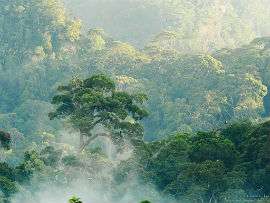Knowledge exchange network releases first oil palm policy report

A knowledge exchange network led by the University of York, which aims to increase the use of scientific evidence to guide oil palm policy, has produced its first science for policy report. The report – 'Change in carbon stocks arising from land-use conversion to oil palm plantations' – focuses on identifying low carbon stock landcover types which could be converted to oil palm production.
Following the network's establishment last year, determining the carbon emissions from conversion of land to oil palm plantations emerged as the top priority among policy developers, advisors and influential stakeholders.
Dr Jennifer Lucey and Professor Jane Hill from the Department of Biology at York, working with scientists from Alterra - Wageningen University, Lancaster University, the Indonesian Agency for Agricultural Research and Development and the UK Royal Society SE Asia Rainforest Research Programme, drafted the new report.
It synthesises the available scientific evidence into a concise document to aid decision making for the development of policies which minimise carbon emissions from oil palm production. The report comes against a background of growing pressure from campaigning organisations such as Greenpeace to sign up to zero deforestation and low carbon policies.
The report's key messages are:
- Conversion of peat soils should always be avoided because these soils contain vast amounts of carbon which are lost over time by fires and oxidation.
- All natural forests, even when very degraded, contain much more carbon than oil palm plantations, and so conversion will result in high carbon losses and should be avoided.
- Grass and shrub lands contain similar or lower amounts of carbon compared with oil palm plantations, and so change in carbon stocks upon conversion to oil palm are likely to be neutral or experience a slight increase. New oil palm plantations should focus on these sites.
Dr Lucey led the study consulting experts in the fields of carbon storage and tropical peat, and collating information from over a hundred scientific publications.
She said: "We wanted to produce a report which unambiguously laid out the state of scientific evidence so that policy makers and industry stakeholders could make informed decisions."
Professor Hill added: "The development of the report was a two-way process and network members provided feedback on the clarity and relevance of the subject matter to ensure that we delivered material which would be useful."
Oil palm is grown in the wet tropics and 80 per cent of palm oil comes from Malaysia and Indonesia. Palm oil is the world's primary source of vegetable oil and production is vital for the economies of these regions. However, expansion of the industry continues to threaten rainforests and peatlands which are important global carbon stores. When these areas are converted to grow oil palm this carbon is released into the atmosphere as CO2, exacerbating climate change. The challenge is to identify areas of land for conversion where carbon stocks are low so that tropical countries can continue to benefit from the highly productive crop, and meet the global demands for palm oil, without releasing millions of tonnes of carbon into the atmosphere.
Provided by University of York
















